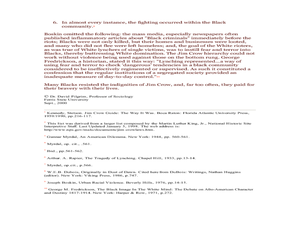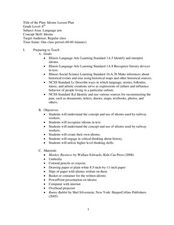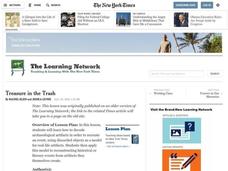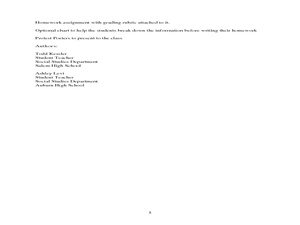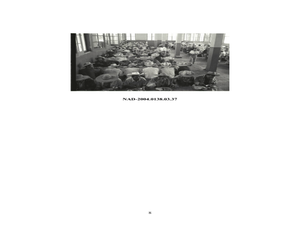Curated OER
Awwwk…..Jim Crow Laws/ Constitutional?
Learners examine the constitutionality of Jim Crow Laws. In this civil rights lesson, students read excerpts of the U.S. Constitution as well as examples of Jim Crow Laws. Learners select Jim Crow laws and then find out what portions of...
Curated OER
John Gary Evans and the Politics of Race
Young scholars read letters written by Evans and Gunton regarding race relations. In this Progressive Movement lesson, students interpret the intentions and tone of the letters to understand contemporary racial beliefs. Young scholars...
Curated OER
The Rise and Fall of the Jim Crow Era
Learners explore African American history by researching the Jim Crow laws. In this Civil Rights lesson, students define the Jim Crow laws, the reasons they were put into place, and how they were ultimately defeated. Learners write a...
Curated OER
The Freedmen's Bureau: Success or Failure?
Students analyze causation concerning Reconstruction policy. They evaluate the success of the Freed men's Bureau concerning land distribution. They examine several documents relating to the Freedmen's Bureau's goal of providing land for...
Curated OER
The Exploration of the Writer, His Louisiana History And the Autobiography of Miss Jane Pittman By Ernest J. Faines
Students identify the significance of the author's experiences on his written work; describe the hardships faced by slaves and plantation owners once the caves were set free; explain the role of the Seceses and why they were a threat to...
Heritage Foundation
Voting and the Constitution
How difficult was it for everyone to get voting rights? Understanding voting rights and the fight to get them for everyone in the United States can be tricky for some learners. However, they are clarified after engaging in the...
Curated OER
Idioms Lesson Plan
Sixth graders discover idioms. In this idioms lesson, 6th graders evaluate idioms and discover their meaning. Students read Runny Babbit by Shel Silverstein and create unique idioms. Assessment rubric is provided.
Curated OER
The Black Hawk War-Reconstructing "Stillman's Run"
Eleventh graders compare several eyewitness accounts of Stillman's Run, and discuss how a historian might use them. They act as historians and try to reconstruct what happened during Stillman's Run from the eyewitness accounts.
Curated OER
Discovering the Past/Considering the Future: Lessons from the Eastern Shore
Students study how the Freedmen's Bureau improved the living conditions among blacks on Maryland's Eastern Shore. They examine Social, Political, and Economic improvements and answer questions.
Curated OER
Change Since 1609
Young scholars recognize how the climate of the Hudson Valley has changed since the last glaciation. They explain these changes using a reconstruction of the land use changes in the Hudson Valley composed of confetti, Ziploc bags and...
National Woman's History Museum
Pocahontas: The Truth vs. The Legend
Young historians study primary and secondary source materials to try and separate the true story of Pocahontas from the myths, fictional tales, and conflicting accounts of her life.
Curated OER
The Rise of U.S. Business and Industry
Eleventh graders examine the industrialization of post-Reconstruction America. In this 20th century American history instructional activity, 11th graders listen to a lecture about the industrial age and then conduct their own research to...
Curated OER
The Great Depression in North Carolina: Experiences of the People
Young scholars explore the Great Depression. In this research skills lesson, students interpret historical evidence presented in primary and secondary sources. Young scholars write their own WPA interviews after they have...
PBS
Primary Sources
Students see how to use primary and secondary sources to investigate history. Whether it is a photograph, book, map, letter, postcard, newspaper, or official document, students can use sources to reconstruct and relive history.
Curated OER
Treasure in the Trash
Learners decode archaeological artifacts in order to recreate an event, using discarded objects as a model for real-life artifacts. They apply this model to reconstructing historical or literary events from artifacts they create.
Curated OER
1968 – A Generation in Revolt
Tenth graders compare and contrast the revolts that took place around the world in 1968. In this global studies lesson, 10th graders research the youth revolts that took place in Paris, Prague, and Chicago in 1968 and create posters and...
Curated OER
Civil War Medicine
Eighth graders discover details about medical care during the American Civil War. In this medical advancements lesson, 8th graders participate in classroom station activities that require them to study doctors, amputation, medical...
Curated OER
A Hoosier Perspective on the March to the Sea: The Diary of William Miller
Eighth graders take a closer look at Sherman's March to the Sea. In this American Civil War lesson, 8th graders analyze the diary entries of William Miller. Discussion questions are included with the entries. Students create illustrated...
Curated OER
With Liberty and Justice for All
High schoolers examine the role of Supreme Court justices. In this judicial branch lesson plan, students consider the civil rights and civil liberties as they investigate Minersville School District v. Gobitis (1940) and West Virginia...
Curated OER
Questions of War and Peace: Using Case Studies to Teach the History of American Foreign Policy
Students read three case studies to focus on how the United States dealt with foreign policy issues. In groups, they read about the decision to drop the atomic bomb, the commitment of troops to Vietnam and wwhether to send troops to...
Curated OER
Tracing the Route of Bracero
Middle schoolers make a map showing the work of a Bracero Worker. In this Bracero lesson, students listen to a worker in an online oral history as he explains his work locations and crops. They use a map to plot the areas he worked and...
Curated OER
Learning From Document - Public Laws
Students research primary sources about the Bracero worker program. In this primary source activity, students investigate two public laws along with other documents to determine if the Bracero worker program was implemented properly....
Curated OER
Learning from Photos
Students use photographs to study the Bracero Labor Program. In this analyzing photographs lesson, students are broken up into groups and given a photograph of Bracero laborers. They predict the answers to questions about the photo...
Curated OER
Women in the Civil War: Ladies, Contraband and Spies
Students interpret historical evidence presented in primary and secondary resources. In this American Civil War lesson, students research diaries, letters, and photographs of women involved in the war.


